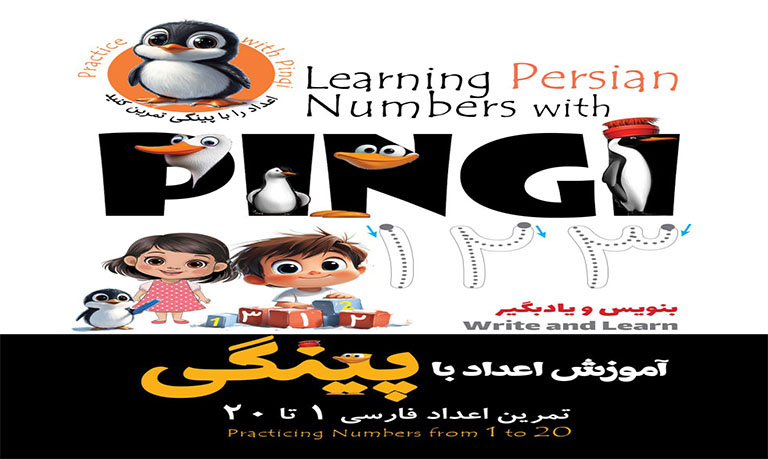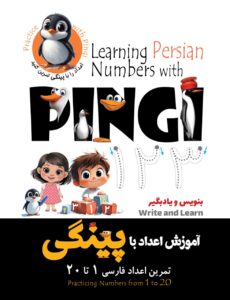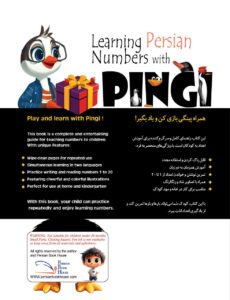
The Ultimate Guide to Using Behavioral Therapy Methods for Influencing and Controlling the Mind
July 14, 2024Learning Numbers with Pingi: A Fun and Creative Path to Teaching Persian Numbers
is precisely designed with this goal in mind: turning the experience of learning numbers into a delightful and effective adventure.
Pingi, the lovable penguin character in this book, accompanies children into the realm of Persian numbers through a blend of games, varied exercises, and short stories. This companionship helps children gain a deeper understanding of basic numerical concepts and strengthen their foundational math skills. In this comprehensive article, we will examine all aspects of the book
“Learning Numbers with Pingi” and explain why it can be one of the best educational resources for preschool_children
as well as first and second graders.
We will begin with a general overview of the book’s unique features and then move forward in a logical structure to detail its advantages and practical ways of using it at home and in educational centers. We will also provide insights on teaching_persian_numbers, creative approaches to engage children in the learning process, and the book’s impact on improving their cognitive and motor skills.
| Section | Description |
|---|---|
| 1. Introduction | Covers the importance of teaching Persian numbers at an early age. |
| 2. Book Overview | Explains the main goals and Pingi’s character. |
| 3. Structure & Content | Details of educational sections, exercises, and English number introduction. |
1. Introduction to the Importance of Teaching Persian Numbers
1-1. Why is Learning Numbers at an Early Age Essential?
Teaching Persian numbers to children aged 3 to 7 years old lays the groundwork for their future understanding of mathematics. Research shows that children who become familiar with numerical concepts at an early age tend to perform better in math and science subjects in subsequent school years
(Source: UNICEF).
In fact, mastering numbers not only directly affects math classes but also plays a crucial role in other cognitive skills. Through
play_and_learning, children can enjoy fun activities while simultaneously learning logical thinking and problem-solving skills. Therefore, introducing a book like “Learning Numbers with Pingi”, which integrates creativity and excitement into the learning environment, can greatly contribute to a child’s holistic growth.
1-2. The Role of Play in Learning Numbers
Traditional educational methods are becoming less effective at capturing children’s attention in a world full of color, light, and technology. Children need an interactive and joyful environment to acquire new concepts. Play-based teaching techniques not only speed up learning but also offer children opportunities to learn by doing, making mistakes, and improving upon them. In
“Learning Numbers with Pingi”, efforts have been made to incorporate play-based activities—such as coloring, interactive dialogues, and short stories—so that the learning process becomes indirect and enjoyable.
2. Getting to Know the Book “Learning Numbers with Pingi”
2-1. The Main Goal of the Book
The primary goal of “Learning Numbers with Pingi” is to teach Persian numbers to children. The book focuses on introducing numbers from 1 to 20 through stories, illustrations, and various games. Alongside introducing Persian numbers, it also leverages English numbers for greater diversity and a preliminary introduction to the global numeric system. By observing and comparing Persian and English numbers, children expand their perspective on counting and number recognition.
Moreover, “Learning Numbers with Pingi” combines creative_learning methods with appealing visual techniques and short stories to engage children in discovering numerical concepts without feeling bored. The bright and colorful illustrations featuring lovable characters keep children excited about practicing their numbers.
2-2. Pingi’s Character: A Gateway to the World of Numbers
Pingi is a curious and kind penguin who serves as the child’s guide throughout the book. Through small adventures and fun games, Pingi leads the child on a journey through the world of Persian numbers. Pingi’s role is significant not only narratively but also psychologically: According to research in educational psychology, using appealing characters in children’s textbooks significantly increases motivation and enthusiasm for learning.
3. Book Structure and Content
3-1. Educational Sections
“Learning Numbers with Pingi” is divided into multiple educational sections. Each section introduces one or more numbers and offers related activities and exercises. This systematic structure helps children progress step by step, acquiring new skills at each stage. For instance:
- Section One: Introducing numbers 1 to 5 through short stories and coloring exercises.
- Section Two: Introducing numbers 6 to 10 with games that involve counting colorful objects.
- Section Three: Presenting numbers 11 to 15 using interactive stories and cutting-and-pasting activities.
- Section Four: Covering numbers 16 to 20 through picture puzzles and group exercises.
3-2. Suggested Exercises and Games
Each section of the book includes specific exercises and games aimed at reinforcing children’s learning of Persian numbers. These activities are designed to activate various skills, such as fine motor skills, pattern recognition, and even language skills. Some examples include:
- Counting Fruits Game: Children count colorful fruits with Pingi’s help and then color them.
- Number Coloring Worksheets: Separate worksheets for each number allow children not only to learn how to write the number but also to color it in their favorite color.
- Number Puzzles: Puzzle pieces that children must arrange correctly to form a single image, corresponding to a specific number.
According to the National Institute of Child Health and Human Development in the U.S., interactive games and indirect teaching significantly enhance children’s visual and auditory memory. Thus, “Learning Numbers with Pingi” attempts to present all educational activities in a playful manner.
3-3. Introducing English Numbers Alongside Persian Numbers
Another unique feature of this book is the inclusion of English numbers alongside Persian numbers. While the primary focus is on
teaching_persian_numbers, the parallel display of English numbers provides children with an early opportunity to recognize the universal form of digits. This exposure not only prepares them for future school learning but also instills the notion that learning a second language or exploring other cultures can be fun and accessible.
4. Practical Usage in the Home and Educational Centers
4-1. A Roadmap for Parents
The first step for effectively using “Learning Numbers with Pingi” at home is creating a suitable schedule. Parents should allocate a specific time of day to reading and playing with their children. The key point is never to force the child to learn; instead, encourage learning naturally through storytelling and playful activities.
For example, you could choose one exercise from the book every morning and spend 10 to 15 minutes working on it with your child. At night, before bedtime, briefly revisit the short story related to that same number. This repetition helps solidify concepts in the child’s mind. You could also use special occasions—like birthdays or holidays—to do coloring or puzzle activities, keeping the child’s learning experience fresh and lively.
4-2. Utilizing It in Kindergartens and Preschool Classes
“Learning Numbers with Pingi” is also well-suited for use in educational settings such as kindergartens and preschool classes. Educators can design group and interactive activities based on the book’s content. For instance, they can divide children into small groups, assign each group a specific number from 1 to 20, and have the group count a particular set of objects or play a game related to that number.
In addition to reinforcing number concepts, these group-based activities help children develop social skills like teamwork, responsibility, and effective communication. Educators may also use large posters or banners from the book to create a more visually engaging learning environment. Lastly, each session can be wrapped up with a Pingi-themed story or mini-adventure.
4-3. Ideas for Educators and Teachers
If you are an educator or teacher planning to use “Learning Numbers with Pingi” in your classroom, here are a few practical ideas:
- Combined Sessions: Start each session by introducing the target number, followed by a related game. Conclude the session with a Q&A or a recap.
- Creative Dramatization: Ask the children to perform a short skit or a physical movement representing the target number. This hands-on approach helps them internalize the concept.
- Friendly Competitions: Organize competitions where children have to quickly find or write the requested number. This activity increases both excitement in the classroom and children’s recognition speed.
5. Key Advantages of “Learning Numbers with Pingi”
5-1. Boosting Self-Confidence and Creativity
One of the main benefits of “Learning Numbers with Pingi” is that it enhances children’s self-confidence in math. When a child can independently identify a number and use it in a fun exercise, they feel a sense of achievement, which in turn increases their motivation to keep learning. Additionally, the coloring and creative activities nurture a child’s imagination, transforming them into an active learner.
According to statistics from the American Psychological Association , children exposed to creative, play-based education at an early age exhibit greater self-confidence in math and science throughout their later school years.
5-2. Building a Strong Foundation for Math Lessons
By offering targeted activities and exercises, “Learning Numbers with Pingi” helps children develop a solid foundation for math before officially starting school. The book’s exercises are designed to teach concepts like counting, basic addition and subtraction, number order, and grouping—key building blocks for future math learning.
If your child acquires these skills joyfully and without stress by ages 5 or 6, they are less likely to experience anxiety when encountering math in school. This helps prevent negative attitudes toward math that many students struggle with in later years.
5-3. Emotional and Motivational Impacts
As noted, Pingi is not just a guide but a friendly companion for children. Kids form an emotional bond with Pingi and his adventures, which makes them more interested in the learning process. Reading becomes less of a “mandatory task” and more of a daily or weekly recreational activity that children eagerly anticipate.
6. Educational Tips and Related Research
According to official reports from the Iranian Ministry of Education, a significant percentage of first and second graders require additional support in understanding fundamental math concepts. These reports highlight the need for structured, goal-oriented introduction to numbers, starting from kindergarten and preschool. “Learning Numbers with Pingi” aligns perfectly with this view, offering an age-appropriate structure tailored to children’s cognitive and motor abilities.
In the realm of educational psychology, university research also shows that intrinsic motivation is the key factor in a child’s academic success. When children enjoy learning about numerical concepts, they naturally dedicate more time to practicing and elevating their skills. Through its storytelling, coloring pages, puzzles, and other suggested play-based activities, “Learning Numbers with Pingi”
effectively fosters this intrinsic motivation.
Some studies indicate that around 65% of effective learning in children under the age of 7 occurs through play and hands-on activities (Source: ResearchGate). These findings confirm that the content of this book is optimally aligned with young learners’ developmental needs.
7. Conclusion and Summary
“Learning Numbers with Pingi: A Fun and Creative Path to Teaching Persian Numbers”
has captured the attention of many parents and educators as a comprehensive and engaging educational resource. Through Pingi’s character, play-based methods, and diverse exercises, children are encouraged to learn fundamental mathematical concepts in a self-motivated and joyful manner.
Using English numbers alongside Persian numbers, creative illustrations, and a focus on multiple cognitive and motor skills are some of the standout advantages of this book. While the core objective is teaching_persian_numbers, the book also contributes to nurturing a positive and creative mindset in children.
Whether you’re looking for a creative approach to help your child learn numbers or you’re an educator aiming to make your kindergarten or classroom environment more vibrant and productive, “Learning Numbers with Pingi” is definitely a top choice. For more information about other educational books for children, feel free to visit our children’s educational articles section.
8. Frequently Asked Questions (FAQs)
1) What age group is this book suitable for?
This book is designed for children aged 3 to 7. However, if your child is slightly younger or older and still needs to strengthen their numerical skills, you can adapt the book’s content to suit their ability level.
2) Does this book only focus on teaching Persian numbers?
The primary emphasis is on teaching_persian_numbers from 1 to 20, but English numbers are also introduced side-by-side for variety and better comparison. The goal is to familiarize children with the shape of English digits and broaden their perspective on numbers.
3) How can parents get the best results from this book?
Ideally, pick one or two activities from the book at a time when the child is fresh and excited. Keep the atmosphere fun and stress-free. If the child becomes tired or uninterested, postpone the activity for another time. Consistency in using this book is key to effective learning.
4) Can preschool teachers use this book in group settings?
Absolutely. Teachers can plan small games or mini-competitions based on the book’s exercises to create a lively and interactive environment. Dividing the class into small groups, with each group focusing on a particular number, is an effective way to use this book collectively.
5) Does the book suggest practical, hands-on methods for teaching numbers?
Each section of the book includes suggestions for hands-on games, such as counting objects, coloring, and puzzles. These activities enable children to grasp numbers more concretely. Additionally, it recommends using everyday items found at home or in the classroom (like crayons, beads, and LEGO blocks) for counting and grouping exercises.
External Links
For more information about creative methods in play_and_learning and other children_books, check out the links below:
- External Link:
UNICEF – Early Childhood Education
Final Note
By blending storytelling, appealing illustrations, and various exercises, “Learning Numbers with Pingi” serves as an ideal resource for parents, caregivers, and teachers who want to strengthennumeracy_skillsin children. By following the recommended principles and strategies in this book—and providing warm support—learning transforms into a meaningful and rewarding experience. Creative approaches in education offer the best guarantee for unlocking children’s potential and preparing them for future academic success.
If you have had any experience using similar educational books or creative methods for child_education,feel free to share your insights with us and other readers. Remember, our role as parents and educators is to create a safe and joyful environment for learning—one in which children feel secure, curious, and genuinely excited about exploring. Here’s to the flourishing of all children on their journey of learning and creativity.







